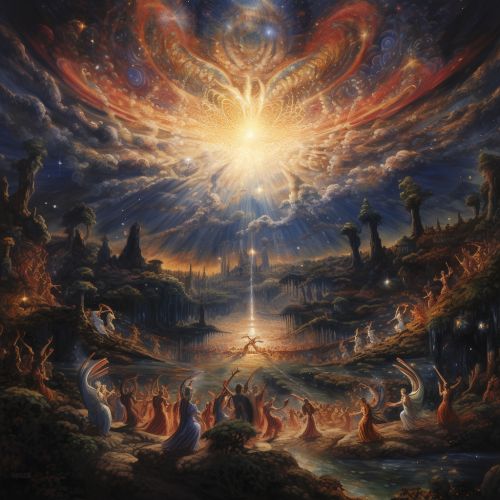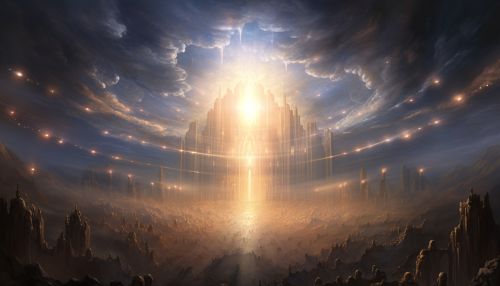Creation Myth
Origins and Types of Creation Myths
Creation myths are traditional narratives that explain the origins of the universe, the Earth, and life itself. They are found in nearly every culture and religion around the world. These myths often serve as a society's cosmological model for understanding the universe and humanity's place within it.


Creation myths can be broadly categorized into five types: ex nihilo (creation out of nothing), chaos, world parent, emergence, and earth diver. Each type represents a different conceptual framework for understanding the process of creation.
Ex Nihilo
Ex nihilo creation myths describe the universe being created from nothing. In these stories, a divine being or beings bring the universe into existence through their thoughts, words, dreams, or bodily secretions. This type of creation myth is common in monotheistic religions such as Christian, Jewish, and Islamic traditions.
Chaos
Chaos creation myths depict the universe as emerging from a state of disarray or confusion. In these myths, order is brought to the cosmos through the actions of a divine being or beings. This type of creation myth is common in Greek and Norse traditions.
World Parent
In world parent creation myths, the universe is born from the union of two parental elements, often personified as deities. These elements often represent contrasting aspects such as sky and earth, light and dark, or male and female. This type of creation myth is common in Maori, Egyptian, and Hindu traditions.
Emergence
Emergence creation myths describe life as progressively emerging from a series of lower, more primitive worlds into the current world. This type of creation myth is common in Native American and Aboriginal Australian traditions.
Earth Diver
Earth diver creation myths involve a divine being or animal diving into the primordial ocean to bring up the mud from which the earth is formed. This type of creation myth is common in Slavic, Finnish, and certain Native American traditions.
Role and Function of Creation Myths
Creation myths play a significant role in shaping the worldview of a culture. They provide a framework for understanding the origins of the universe and the nature of existence. They often address fundamental questions such as why the world exists, what the purpose of life is, and why things are as they are.
Creation myths also serve a social function. They help to establish social norms and values, and they often legitimize social institutions and power structures. For example, a creation myth that portrays the universe as the result of a divine plan might be used to justify the authority of a religious or political leader.
In addition, creation myths often serve a psychological function. They provide a sense of identity and belonging, and they offer comfort and reassurance in the face of the unknown. They help to explain the mysteries of life and death, and they often provide a narrative framework for understanding human suffering and adversity.
Interpretation and Analysis of Creation Myths
The interpretation and analysis of creation myths can provide valuable insights into the beliefs, values, and worldview of a culture. Scholars often approach these myths from a variety of perspectives, including historical, psychological, sociological, and comparative.
Historical analysis involves examining the historical context in which a creation myth was developed and how it has evolved over time. This can reveal important information about the society's history and cultural development.
Psychological analysis often involves applying theories of psychology to the interpretation of creation myths. For example, the work of Carl Gustav Jung and his concept of archetypes has been influential in this field.
Sociological analysis focuses on the social functions of creation myths, such as their role in establishing social norms and values, legitimizing power structures, and providing a sense of identity and belonging.
Comparative analysis involves comparing creation myths from different cultures to identify common themes and patterns. This can provide insights into universal aspects of human thought and experience.
Conclusion
Creation myths are a fascinating aspect of human culture, providing insight into our attempts to understand the universe and our place within it. They serve a variety of functions, from explaining the origins of the world to establishing social norms and values. The study of these myths offers a window into the beliefs, values, and worldview of different cultures, and contributes to our understanding of the human experience.
